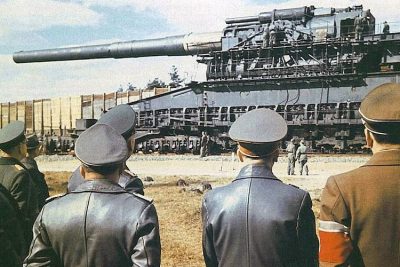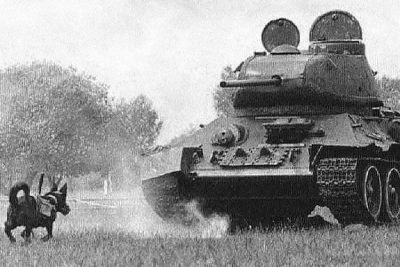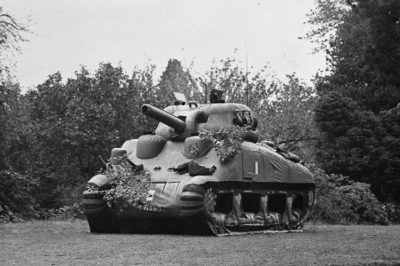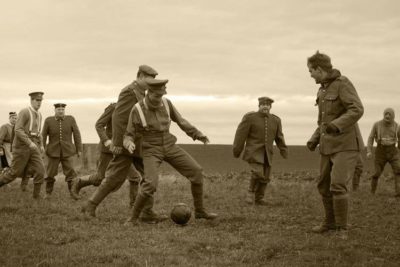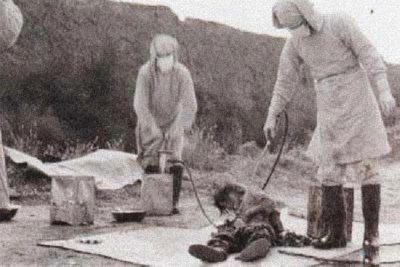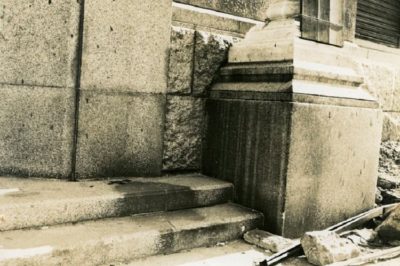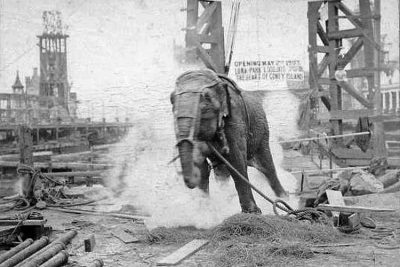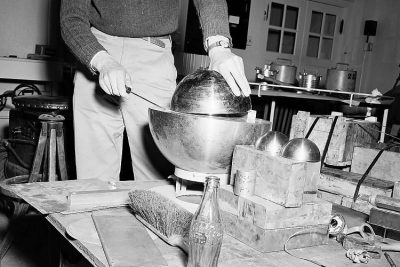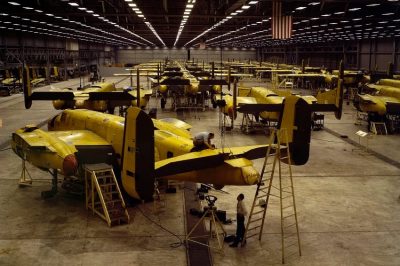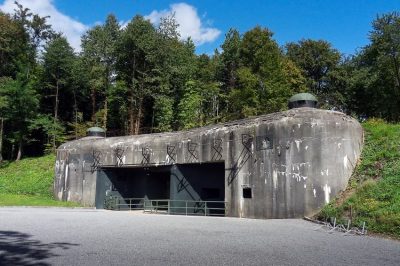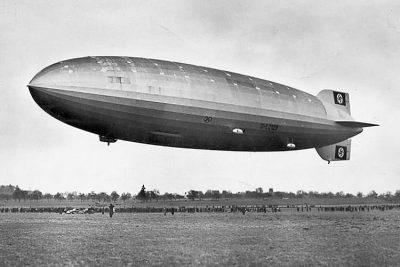The post World War 2– Direct and Indirect Intervention in World War Two by the United States of America appeared first on .
]]>The United States of America was a major force in the war but did not join until late in proceedings following a strong non-aggression pact after the devastation of World War I. Their citizens did not want to meddle in European affairs. Expansionism from Japan and Germany changed this however bringing about a need to act but it wasn’t until the Japanese attacked the US Naval fleet on home soil (Pearl Harbour) that the President retaliated. Germany – allies of Japan – declared on the US which meant American soldiers would directly join the fight in Europe also.
Land lease
Before the US even joined the fighting, they intervened. Having strong ties with the Allied Forces (UK, France and Russia) they passed an act which stated,
“… that the U.S. government could lend or lease (rather than sell) war supplies to any nation deemed “vital to the defense of the United States.” Under this policy, the United States was able to supply military aid to its foreign allies during World War II while still remaining officially neutral in the conflict.”
They gave much of this to one of their allies in World War One. At a time when Nazi Germany had overthrown much of France and had almost surrounded the British Isles the US kept the British people fighting. It meant they could keep competing against Germany until the Americans joined the fight.
The Logistics of War
Here are a selection of public domain photographs which show the aid which the US was able to send to the Allied Forces and of course use themselves. The 40’s brought about an economic boom with a wealth of manpower, natural resources and industrial strength.
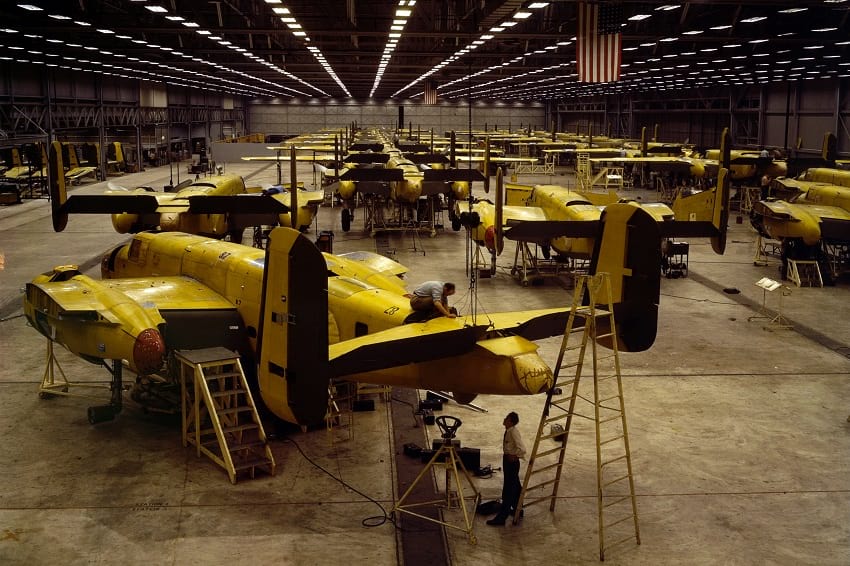
Assembling the North American B-25 Mitchell at Kansas City, Kansas (USA). (LOC)

Part of the cowling for one of the motors for a B-25 bomber being assembled. (LOC)
The B-25 Bomber (The North American B-25 Mitchel) became one of the most famous aircraft of World War II due to its effectiveness and flexibility. Most notably it was used by the US in retaliation for the Pearl Harbour attacks by Japan but they were also sold to the British and Soviet Air Forces. It was the precursor to the B-29 which would transport and drop the Atom Bombs on Nagasaki and Hiroshima which would effectively signal the end of World War Two.
“It [the B-25] required 8,500 original drawings and 195,000 engineering man-hours to produce the first one, but nearly 10,000 were produced from late 1939, when the contract was awarded to North American Aviation, through 1945.”

Gunnery practice on USS Biloxi (CL-80). (U.S. Navy)
As important as aircraft in World War Two were naval craft. The USS Biloxi – named after a city in Mississippi – was a light cruiser type of battleship. It was built in Virginia by Newport News Shipbuilding and Dry Dock Company. Biloxi was awarded nine Battle Stars for services in the Pacific Campaign during World War II (Between the US and Japan) including the famous battle of Iwo Jima – a small yet important atoll near the Japanese mainland. Despite all of its service, Biloxi never lost a single crew member and only received small damages during a Japanese kamikaze bombardment towards the end of the war. The kamikaze fighter actually hit the deck of the ship but the bomb on board failed to explode.

Launch of USS Lexington (CV-16), 1942. (U.S. Navy)
The USS Lexington was one of the first-ever aircraft carriers built. During the attack on Pearl Harbour the Lexington was further away in the Pacific which was a major mistake on the part of the Japanese army. Lexington would go on to have success in the war including sinking a famous Japanese aircraft carrier called Shoho and raiding several others. After being hit by torpedoes and aircraft bombs the USS Lexington was scuttled – sunk deliberately by its own crew. Its remains are still on the ocean floor not far off the coast of Australia.

Halftrack infantryman with Garand rifle. (Alfred T. Palmer / LOC)
Half-Tracks – as the name suggests – are hybrid tanks with tank tracks at the back and wheels at the front. They make it possible to traverse various terrains at high speeds yet unlike tanks, they provided easier accessibility for transporting troops, if having to make a quick disembarkation for instance.
Alfred Palmer was a famous American photographer, most notably active during the Second World War. While rightly so, the allied soldiers, generals and world leaders gain most of the plaudits for their contributions to the war effort, photographers and videographers played an important role in making sure that the time was chronicled and while never be forgotten.
 Here is a staged photograph of an infantry man with an M1 Garand, a famous semi-automatic rifle at the time of the Second World War. It is immortalised in many video games such as Call of Duty and historic movies. Its bolt-action sound is instantly recognisable and brilliant for dramatic cinematography. The US Army started using it in 1936 after being developed in Springfield, Massachusetts.
Here is a staged photograph of an infantry man with an M1 Garand, a famous semi-automatic rifle at the time of the Second World War. It is immortalised in many video games such as Call of Duty and historic movies. Its bolt-action sound is instantly recognisable and brilliant for dramatic cinematography. The US Army started using it in 1936 after being developed in Springfield, Massachusetts.

Woman workers at the Douglas Aircraft Company Long Beach plant, California. (Alfred T. Palmer / LOC)
While most of the acclaim goes to males in World War Two, the massive contribution made by females largely goes unnoticed. However, 350,000 women served in the Armed Forces alone including pilots, navy and medics. By the end of World War Two, the percentage of female workers in the US rose to 37% and provided a great jump towards equality.

“We Can Do It!” by J. Howard Miller was made as an inspirational image. (National Archives)
For constructing planes alone (a massive factor in winning the war) women took up 65% of these positions compared to 1% before WW2. First Lady at the time, Eleanor Roosevelt encouraged women to sign up, largely inspired by British women doing the same in previous years. Propaganda such as a character called ‘Rosie the Riveter’ illustrated the effect a women could have in the war effort, not just on the front lines. A female Uncle Sam if you will.

An African American mechanic working on motor maintenance section, Ft. Knox, KY. (LOC)
African Americans also had a vital part to play in World War 2. Similar to women, in previous years they were deemed by many sections of society as second-class-citizens but by the 1940s their positions had improved. Again, the war broke more segregation barriers, at least internally. 2.5 million African Americans registered for the war draft and achieved tremendous acclaim for their efforts. For example, Private Ernest A. Jenkins who was awarded the Silver Star for his part in the Liberation of Chateaudun in France. The star was awarded by famous General George S. Patton.

This photo in New Orleans shows an Aviation Machinist, Signalman and two pharmacists at the finale of the Second World War. (U.S. Navy)
Author’s Opinion
These photographs show the incredible logistics behind a war as huge as World War Two. The amount of time, resources and manpower needed as a starting point is absolutely massive in order to keep the armed forces stocked and ready to fight. Even before the US enters World War Two the fact they were supplying the allies such as Britain, France and Russia was an essential assistance. If they did not, perhaps Germany would have broken British resistance and been able to concentrate on the Soviet Union. Similarly, if they did not go to war with Japan, perhaps Japan would have gave the Soviets a bigger fight, which would in turn help Germany.
What these photos do not show is the abhorrent suffering which comes with war. It is a horrible thing. There are a few silver linings however such as the progression in terms of Racial and Sexual equality due to the war effort. This happened in many countries involved. And of course, the many unions created after the war in order to stop the same thing happening again. But it must be repeated that war is a crippling thing.
These photos, but more so photographs which show the sufferings of the war must be displayed to all. Such as the Nazi death camps, the starvation, separation and animalistic instinct which fighting brings. For as writer George Santayana states,
“Those who cannot remember the past are deemed to repeat it.”
Enjoyed this article? Also, check out “Dazzle Camouflage: The Wonder That Worked in World War I“.
Fact Analysis:
STSTW Media strives to deliver accurate information through careful research. However, things can go wrong. If you find the above article inaccurate or biased, please let us know at [email protected].
RELATED
The post World War 2– Direct and Indirect Intervention in World War Two by the United States of America appeared first on .
]]>The post Dazzle Camouflage: The Wonder That Worked in World War I appeared first on .
]]>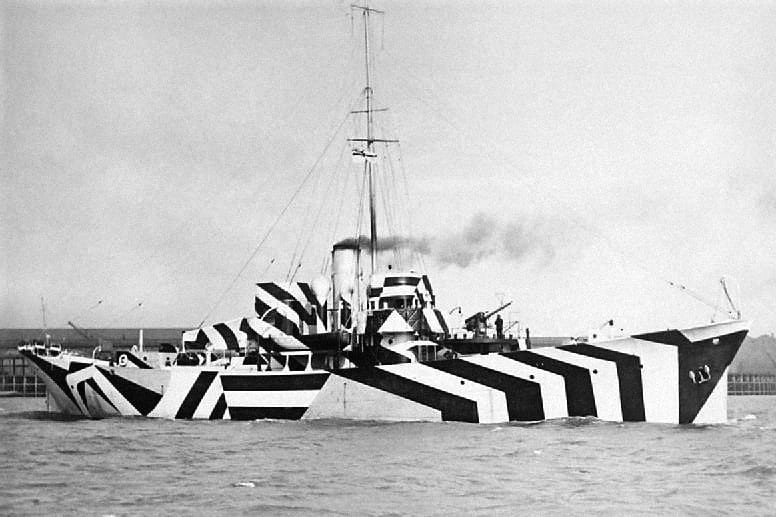
HMS Kildangan with dazzle camouflage, 1918. (Imperial War Museums)
Dodging the enemy in a battlefield is always a strategy of paramount importance. During World War I, Germany came up with U boat, the submarine, which could move below the surface of the water. The allied ships, which could only surf on the water surface, became their easy target. The heavy-weight smoke bellowing ships could scare hide between the sky above and the water below. Search for their camouflage led to a crazy idea: if you can’t conceal (from the enemy), confuse (the enemy) with paint of colour patterns. The idea, called dazzle camouflage, was instantly adopted. Little thought was given to its on-ground efficacy. But the tactic didn’t last for long.
Conventional camouflage was not tenable for warships
World War I was not the era of guided missiles which can hit moving targets with precision. The naval battle, then, was more about visual acuity and firing on an anticipated point in the distance. The U boats launched by Germany were capable of navigating below the surface of the water and emerge at a firing distance from the ships of allied forces. Something had to be done, quickly, to save allied warships. The general rule of camouflage is to blur the distinction between an object and its surroundings. Like a chameleon turning green in green foliage, and brown in a heap of dried leaves. But this couldn’t apply to ship floating between skyline and the choppy sea waters. Clouds form and disappear, the smoke from chimney leaves a trail which is hard to conceal. Add to this changing colours in the skyline, and it becomes clear that there could be no way out to merge the gross appearance of a boat with the unfolding of colour patterns in its background.
Hiding got reversed to brazen revealing
So, what could be the possible alternative? An out-of-the-box solution came from British marine painter Norman Wilkinson. His take on the problem was simple. Given that concealing of sea vessels was not possible, why not make them more prominent over the surface of the water? Prominence would be imparted by painting the body of the ship with myriad shapes and designs in bright colours. That would surely surprise, if not shock, the enemy. The new image of the ship would be a sharp departure from the image of it in the enemy’s mind. Hence, the opposite side is bound to be overawed with the spectacle. And that’s quite a gain in battle conditions which call for an unwavering concentration and a cool mind. The enemy is momentarily put on the back foot and forced to rethink on the offensive. The idea was called Dazzle camouflage. There are many references of such out-of-the-box fooling tactics in history. Like Horse of Trojan used by the Greeks to enter the city of Troy. The reference of a golden deer in Ramayana. It so enticed Sita that she compelled her husband Ram to get it for her. In fact, winning a battle has always involved conning of the enemy in some way or the other.

Illustration of how a ship would look through a periscope with and without the dazzle camouflage. Dazzle camouflage also made it difficult to estimate a target’s range, speed, and heading.. (Wikimedia Commons)
Dazzle camouflage became an instant rage
The idea of dazzle camouflage was an instant hit and more than 1200 ships were colour painted for security. These included the passenger and merchant ships as well. The sister ship of world fame Titanic, RMS Olympic, was also painted for dazzle camouflage.

RMS Olympic camouflage. (Wikimedia Commons)

HMS Argus (1918).

S.S. Alloway (1918).
The very audacity of the idea was a dampener for the enemy. That is, a ship acquiring a more visible frame, as if to say: here I am, hit me. Understandably, the new look of allied warships challenged the sensibilities of a naval commander. Consequently, they erred in judging the distance of the ship and their gun/cannon fire strayed from the target. An experiment on sailing ships did support the idea to some extent. Some dazzle ships were presented for trial. Gunners were directed to aim at these boats and shoot. The gunners, in some cases, missed the target by as much as 55 degrees. Variegated shapes and patterns on ships were a positive drag on the aiming exercise of the opponent. Hence the boats escaped the enemy onslaught. The target being visibly different from one on which the enemy had practised in mock drills, proved to be an added challenge in the do-or-die battle situations and proved to be a disadvantage for the German Navy. That is, in those days of World War I when weapons were simpler and unsophisticated.

The intended effect of Dazzle Camouflage. (Wikimedia Commons)
Not a sure-shot security feature
On the flip side, dazzle camouflage had its limitations. It wasn’t a foolproof security shield. A mail boat named RMS Leinster, done up in dazzle camouflage, was hit and destroyed by a torpedo. No wonder, the dazzle camouflage became redundant as sophisticated war weapons arrived on the scene during World War II. Reason being that the use of automated guns and ammunitions removed much of human guesswork in the war zone. Nevertheless, the dazzle camouflage is a part of history and a surreal lesson in psychological warfare.
Can be seen in the animal world

A herd of zebras. (Michael Mwakalundwa / Wikimedia Commons)
Dazzle camouflage is very much a part of nature’s order. Zebras are a typical example. A herd of Zebra, from a distance, appears as a pattern of black and white stripes rather than a group of animals herded together. We humans can decipher the nature of this animal group from distance. But a wild predator may only see waves of white and black lines in the animal aggregation and may decide to change track. Thus the dazzle camouflage seems to pre-empt a possible predator attack on Zebras.
Seemingly derived from an art form
The idea of dazzle camouflage ostensibly came from an art form, cubism, invented by Pablo Picasso around 1907-08. Cubism is an exercise in abstracting a known shape and size. Picasso’s painting of human and animal forms, distorted to the hilt and were yet recognizable. Thus black and white geometric distortions, the dazzle camouflage, is a work of art in the same measure as a tool of camouflage in the battlefield of early 20th century.
Has applications in many other fields
Mitch Cope, co-founder Design 99 at Detroit, Michigan, has observed that buildings with design pattern were safer from vandalism as compared to those having no such design. Going by this premise, the Design 99 studio created abstract colour designs on abandoned housed, and claimed that it acted as a deterrent for the vandals and burglars.
So, like signage we see in market place and highways, coloured patterns have an indelible impact on our psyche. That this effect could be extrapolated on to a naval battle in World War I, will remain food for thought for defence experts as well as the professional painters/artists for all times to come.
Enjoyed this article? Also, check out “Ghost Army of 23rd Headquarters Special Troops Dodged Enemy by Fooling and Scooting“.
Fact Analysis:
STSTW Media strives to deliver accurate information through careful research. However, things can go wrong. If you find the above article inaccurate or biased, please let us know at [email protected].
RELATED
The post Dazzle Camouflage: The Wonder That Worked in World War I appeared first on .
]]>The post Japanese Kamikaze Pilots: Transcending Life and Death for their Country appeared first on .
]]>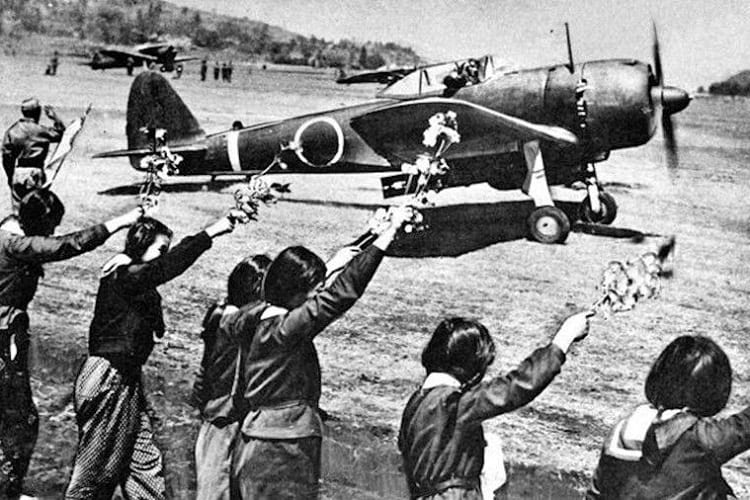
Schoolgirls cheering a Kamikaze pilot with flowers before his final takeoff. (Hayakawa / Wikimedia Commons)
Kamikaze is a Japanese word that loosely translates to ‘divine wind‘ or ‘spirit wind’. The word was used to describe two storms that saved Japan twice from invading Mongol fleets under the fifth Khagan of the Mongol Empire, Kublai Khan. The Mongols invaded Japan twice, in 1274 and 1281, but both the times a typhoon drowned their ships and resulted in deaths of several soldiers. The Mongols never tried to invade Japan again.
Much later during World War II, the word, ‘Kamikaze’ was used to describe pilots of the Japanese Special Attack Units who executed suicide attacks on the Allied Powers. Kamikaze attacks were aircraft loaded with the arsenal to strike American ships.
After Japan lost the Battle of Saipan in July 1944, it was decided drastic measures were to be implemented to defeat the Allied Powers. Vice Admiral Takashiro Ohnishi, the commander of the Japanese First Air Fleet, observed that a plane crashing into a warship would inflict more damage than several planes firing at it. This was then used as a combat tactic to mete out maximum harm to the Allies.
It is also considered that the idea for this attack came from First Lieutenant Fusata Iida’s suicidal plane attack on the Naval Air Station Kaneohe Bay on December 7, 1941. 9 minutes before the Japanese attacked Pearl Harbour in Hawaii, Iida’s plane was hit and he went down with the plane by crashing it into the US Naval Air Station causing severe damage.
The Kamikaze Attacks
The first suicide mission was on October 25, 1944, in the Battle of Leyte. 5 Zero aircrafts flown by the Kamikaze Special Attack Force pilots were escorted by Japanese pilot Hiroyoshi Nishizawa to the aircraft carrier USS St. Lo. It was the first major warship to suffer the wrath of a Kamikaze attack. Enormous fires broke out on the warship as a result, which further led to a massive explosion in the bomb storage of the ship. The damage was done, and the warship sank within an hour.

Preparing Mitsubishi Zero A6M5 fighter aircraft for Kamikaze attacks. (Wikimedia Commons)
USS Essex suffered extensive damage on November 25, 1944, from a Kamikaze crash when it landed among planes ready for takeoff aboard the ship. Apparently, 15 Americans were killed and 44 wounded.
On March 19, 1945, USS Franklin was within 80 km of the Japanese mainland, when a little before dawn, a Japanese aircraft dropped two 250 kg semi-armour-piercing bombs on it. It is unclear whether or not it was a Kamikaze attack. The bombs ignited fires all over the warship, causing the heaviest loss of personnel by any carrier.
During the Invasion of Okinawa from April 1 to June 22, 1945, USS Bunker Hill was hit by 2 Kamikazes one after the other in 30 seconds on May 11, 1945, setting her ablaze. Fatalities were beyond 600 with 393 dead, 264 wounded and 43 missing. This was the second biggest loss of personnel by any warship.

USS Louisville after being attacked by a kamikaze. (U.S. Navy photo 80-G-363217)
The kamikaze effect
A pilot and an Imperial Japanese Navy Admiral, Masafumi Arima is said to have invented the Kamikaze approach. It is said that before attacking a US warship, he took off his rank, badge and other symbols, and told his men that he was not coming back. Though there was no account of damage incurred by any American carriers that day, Arima was never seen again and presumed dead. He was given the rank of Vice Admiral posthumously.
April 6, 1945, is marked as the most historic day of Kamikaze attacks in WWII when more than 350 Kamikaze aircrafts laid the assault on the Allies simultaneously. USS Laffey was attacked by 20 Kamikaze aircraft, all at the same time.
In spite of the relentless efforts and sacrifice of the Japanese Kamikaze pilots, their success rate was estimated to be only 14% to 19%. Even with a low success rate, they were able to inflict substantial damage to the Allied Powers. The fury they unleashed, not only gave them a place in history as Japan’s most dangerous weapons in WWII but also enabled them to successfully sink 47 warships, damage 386 warships, kill approximately 4900 soldiers and injure 4800 others.
The kamikaze pilots
Many Japanese pilots volunteered to become Kamikaze pilots but there were several who did not wish to volunteer and some who did not. Pilots were given a slip of paper with their name written on it with 3 options – willingly volunteer, volunteer, do not volunteer. Due to the fact that the slip to be turned in had their names, many pilots unwillingly volunteered.
There are also stories of those who did not volunteer but were projected as volunteers by their commanding officers. The Kamikaze Pilots were told that their destiny was to save Japan from the enemy just like the Kamikaze typhoons had done centuries ago.
Young students were recruited for this suicide mission, some only 17 years of age. The Pilots underwent 40-50 hours of training, after which they were accompanied by experienced pilots to their targets.

Corporal Yukio Araki (age 17) holding a puppy before his Kamikaze suicide mission. (Wikimedia Commons)
A Kamikaze Pilot had to take a 5 Point Oath as soon as he joined a Special Attack Unit:
1. A soldier must make loyalty to his obligation.
2. A soldier must make propriety his way of life.
3. A soldier must highly esteem military valour.
4. A soldier must have a high regard for righteousness.
5. A soldier must live a simple life.
One of the rituals of a Kamikaze Pilot was to write a letter to his parents which would be sent to them soon after the completion of his mission. One such letter still exists today, written by young Ensign Kiyoshi Ogawa to his parents. Ogawa happened to be piloting the second aircraft that hit USS Bunker Hill causing enough damage for the warship to be out of action for the remaining duration of the war.
The next ritual was wearing the One Thousand Stitch Belt known as Senninbari Haramaki. This belt was made by Japanese women standing in public places, asking a thousand women passing by to place a stitch each on the belt. It was a good luck charm for the Kamikaze Pilots. The final ritual was the consumption of a holy potion which would guide the pilot to his destiny. Finally, the pilot would board his aircraft amidst bombs and take off on a flight of providence.
A befitting coffin
A Kamikaze Pilot’s ride was the Mitsubishi A6M2 designated the official name ‘Zero‘. Almost 30 feet in length with a wingspan of 39 feet, it could fly at a maximum speed of 332 mph. The Zero became a coffin for Kamikaze Pilots, aptly named as they reduced to nothing in their mission to save their country.
Recommended Read:
The Kamikaze Hunters: The Men Who Fought for the Pacific, 1945
Fact Analysis:
STSTW Media strives to deliver accurate information through careful research. However, things can go wrong. If you find the above article inaccurate or biased, please let us know at [email protected].
RELATED
The post Japanese Kamikaze Pilots: Transcending Life and Death for their Country appeared first on .
]]>The post Anti Tank Dog: The Soviet ‘Masterplan’ that Backfired to Disastrous Effects appeared first on .
]]>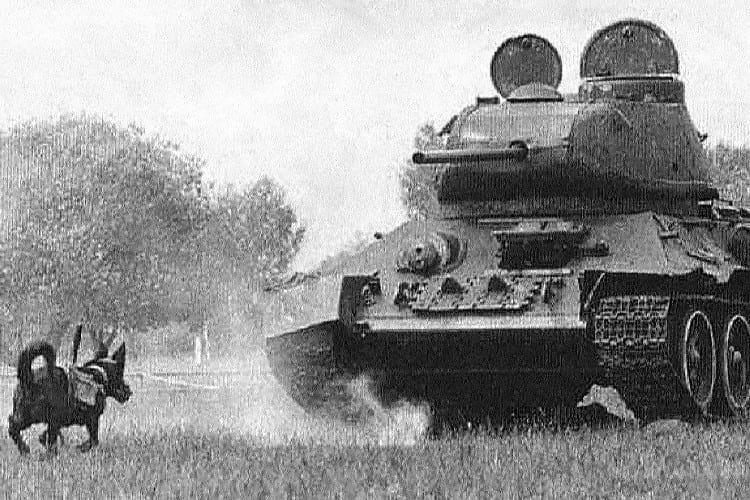
Anti Tank Dog: A war dog approaching a tank. (♪_Lisa_♪ / Flickr)
During the Second World War, the Soviet Union came up with the novel concept of ‘Anti Tank Dog’ or ‘Hundminen’, also commonly known as ‘Dog Mines’. They used dogs, particularly German Shepherds, and attached explosives to their backs. These dogs had been specifically trained to look for food under the German tanks- however; they inadvertently proved to become one of Germany’s greatest weapons during the First World War.
Background
When dogs first began to be employed during the First World War, their tasks were fairly basic. They were deployed primarily for conducting searches, and to warn soldiers about any incoming dangers- such as gas or artillery attacks. It was the Soviets, who first began the use of animal weaponry during the war.
From the 1920s, more emphasis began to be put on dogs, and they began to aid the military. In 1924, a ‘dog training school’ was established in Moscow, as the dogs were intended to be used in a multitude of fields in the war efforts, including communication, search, as well as rescue missions. In order to be able to carry out these nuanced tasks, the dogs needed to be trained by experts. The preferred breed amongst those enrolled in these do training schools, was the German Shepherd.

Soviet military dog training school, 1931. (Wikimedia Commons)
The military also hired police dog trainers, circus trainers, animal scientists, and hunters, to train the dogs already at the training camps that had been set up.
Training the dogs & initial set-backs
The dogs were initially trained to do simple tasks like carrying supplies, tracking mines and rescue missions, which they seemed to have a natural affinity towards. In the early 1930s, the idea to use dogs to behave as anti-tank weapons took shape, and the dogs at training camps subsequently began to be instructed for these new missions.
The initial idea behind the ‘Anti Tank Dog’ was that the dogs would run up to the tanks, with a bomb strapped to them. On reaching the tanks, they were supposed to pull on a belt with their teeth in order to release the bomb, and then quickly return to their handler. The handler would then either detonate the bomb with a remote, or a timer would be set and the bomb would go off at the set time.
Anti tank dog: A novel idea
However, this idea did not work out very well as quite often the dogs would be unable to release the bomb with their teeth. The task proved to be quite harrowing for the poor animals and they would return to their handlers without having released the bomb, and would be severely reprimanded as such a mistake could prove fatal on the battlefield. Another problem the dogs faced that soon became a detriment to the program, was the fact that they had been trained to go under a single tank. When they saw multiple tanks, the dogs would get confused and return to their controllers with the explosives still attached to their backs.
In order to simplify things and combat the shortcomings of the program, the Soviets came up with a new idea. The dogs were trained to find an enemy tank, but this time around, the bombs would explode once they came in contact with their target. The hapless dogs were taught to dive under the tanks of the enemy, while a wooden lever would be sticking out of their harnesses- which on coming in contact with the tank would trigger the explosives and blow up the tank, as well as the carrier-dog to ashes.
The training procedure was inhumane and brutal, with the dogs kept starving, and food was kept under the practice tanks for them, thus conditioning them to believe that all tanks had food under them. To take their training one step forward, typical sounds associated with battle, such as gunfire, were added to the background during their training so that the dogs would get acclimatised, and not get scared in the battlefield.
The backfire of the anti tank dog
By 1941, the dogs began to be used quite commonly during the war, and around 30 canines were deployed at the frontlines of the Eastern Front, when the Germans attacked. However, the masterplan of the Soviets to employ dogs as anti tank weapons backfired miserably due to multiple reasons.
On the battlefield, the animals were being physically shot at and they were definitely not equipped to execute the mission under such circumstances. They refused to dive under the tanks out of fear, and would retreat to the trenches- often detonating the bomb there, inadvertently killing or grievously injuring many of the Soviet soldiers themselves.
Another reason for the failure of Anti Tank Dog was that these animals had been trained with Soviet tanks, whose engines emitted a diesel smell, which the dogs got familiarised with. Instead of diving under German tanks that used petrol, these dogs would often dive under the familiar Soviet tanks in search of ‘food’, once again setting off the bomb, and leading to the death of many Soviets.
Some of the dogs, however, persisted and continued to run beside the tanks until they stopped, but were shot fatally in the process. Out of the 30 dogs from the original pack, only four of them had been able to actually detonate their bombs near German tanks. Six dogs had retreated to the trenches of the Soviets and exploded, and three of them had been shot and were taken away by the Germans.
Some debatable success of the anti tank dogs
The Anti Tank Dogs did, however, have some degree of success during the war. At the Battle of Kursk, sixteen dogs had been deployed, and twelve German tanks were consequently destroyed. This mission by the Anti Tank Dogs is reportedly one of the most successful ‘anti tank’ ventures. The Soviets also said that the Anti Tank Dogs had destroyed a total of 13 tanks at Stalingrad.
According to the Soviet government’s reports, the Anti Tank Dogs had supposedly destroyed approximately 300 tanks. However, this hardly seems believable and was probably fabricated by the Soviets, who were clearly trying to justify the merciless sacrifice of these animals.
The end of the anti tank dog
Even though the use of Anti Tank Dogs had decreased significantly 1942 onwards, dogs were continued to be trained for the purpose up until 1996. Although the Soviets have used Anti Tank Dogs more than any other nation, some other countries like Japan and the United States trained them for use as well.
Even in recent times, around 2007, bombs were attached to dogs, when rebels had tried to use them in a similar manner to the Soviet Anti Tank Dogs, and deploy them during the Iraq War. However, only one incident was reported about a bomb exploding while being attached to a dog. Protests rose all over the world, and many Muslims too expressed their outrage.
Enjoyed this article? Also, check out “Ghost Army of 23rd Headquarters Special Troops Dodged Enemy by Fooling and Scooting“.
Fact Analysis:
STSTW Media strives to deliver accurate information through careful research. However, things can go wrong. If you find the above article inaccurate or biased, please let us know at [email protected].
RELATED
The post Anti Tank Dog: The Soviet ‘Masterplan’ that Backfired to Disastrous Effects appeared first on .
]]>The post Invasion of Normandy: Largest Amphibious Invasion That Probably Changed the Course of History appeared first on .
]]>
US troops wading through the Omaha Beach. (Robert F. Sargent / National Archives and Records Administration)
The invasion of Normandy is a significant event that changed the course of World War II. It was the first time the Allied countries were able to threaten Germany’s control. For Europe, this would mean freedom from Nazi control, whereas for Hitler this would mean the beginning of the end of the Third Reich. This invasion was, and also impressively, still is the largest seaborne invasion in history.
The goal of the invasion was to liberate France and the rest of Western Europe from the German captors. Majority of the troops were from USA, UK and Canada and there were some troops from Poland, Belgium, Czechoslovakia, Greece, and the Netherlands. The invasion was being considered since America entered the war in 1942, and finally started being planned in August 1943 during the Tehran Conference in Iran.
Through eyes of the allies

Commander Dwight D. Eisenhower. (U.S. Army)
The invasion of Normandy, codenamed Operation Overlord, is the perfect exhibit of impeccable and thoughtful planning. The Allied countries, led by Supreme Allied Commander Dwight D. Eisenhower, did not leave even the smallest detail unplanned.
They planned the day of their invasion in accordance with the phases of the moon; full moon would provide illumination during the night for aircraft and gliders, and it would also provide for the maximum tidal force during spring tides to reveal obstacles that the Germans would have placed for them.
The perfect day came on 6 June 1944, even though the weather on the days prior to it made it seem like the attack would have to be cancelled. The weather was in such a terrible state that many of the German troops and senior officers, including Field Marshal Erwin Rommel, were on leave because they believed that an attack would be impossible in these conditions.
Apart from planning the real invasion, Eisenhower also planned numerous deception tactics. Operation Fortitude was a deception strategy to convince German High Commander that the attack on Normandy was going to be purely diversionary by creating an appearance of attacks in different locations like Pas de Calais. Double cross agents were also employed to persuade the German High Commander of deceptive plans, and also to gather information from the inside. The work of these agents coupled with Operation Fortitude was very effective for their upcoming invasion.
Eisenhower also planned a rehearsal of the invasion, called Excercise Tiger, so that his troops could adjust their sight, smell, and sound to the naval bombardment. Due to a miscommunication regarding the timing of assault, at least 700 American men were sacrificed in friendly fire. Though this rehearsal did help solidify the mock plans and word of the agents. Another innovative deception they carried out was dropping dummies from aircraft that actually contained explosives. The meticulousness does not stop there, Eisenhower also made the troops practice blowing up professionally engineered replicas of defence items for months before the real invasion; all the intricate details of which they knew about from their cross agents.
The plan for the real invasion was to attack five of Normandy’s beaches. They were codenamed and assigned to a country for sea landings – Utah and Omaha assigned to USA, Sword and Gold assigned to the UK, and Juno assigned to Canada. The total number of troops that landed on D-day by air and sea combined were more than 150,000, this number increased to over 850,000 as the invasion continued. Thanks to the deceptive strategy played by the Allies, they faced very little defence on most of these beaches. Though, Omaha was a different story. The defence at Omaha was cruel; many of the soldiers didn’t even make it out of the boats because the Nazis line of attack was aimed at the front of the ship. Due to this type of aim, many of the soldiers in the front were hit as soon as the doors opened.

Aerial photo of Omaha beach during the invasion with American Liberty ships providing cover for the vessels unloading on the beach. (US National Archives)
Despite their meticulous planning the English Channel ended up being an obstacle for the troops due to which they had to tow in 2 fake harbours codenamed Operation Mulberry. They needed these ports to protect ships from the weather and to have a ready opportunity for ground transport. These harbours were built by more than 20,000 British workers working at full capacity. Even though the creation of these harbours proved to be a maritime challenge, they were built within 7 months.

Cargo being unloaded at Omaha beach on the first day of the assault. (United States Coast Guard)
Mistakes committed by Nazis

Erwin Rommel. (German Federal Archive)
Hitler was aware that there was a threat of invasion by the Allied countries, but he didn’t know where exactly they would strike. He put Field Marshal Erwin Rommel in-charge of defence systems. It is said that Rommel felt Germany should surrender as he believed they did not stand a chance against the Allies. He said that once the Allies had secured a beachhead, the war would be in their favour and hence wanted to stop the invasion at the beaches.
As part of their defence system, Rommel ordered the building of a 630 km Atlantic Wall all the way from Norway to the Spanish border. The series of fortifications kept at the Wall would have been quite effective had they not focused on building such a thick defence only at Pas de Calais, which they supposed was the focus of attack.
For the longest time, they believed that Normandy attacks were just a diversion and kept waiting for the attack to begin at Pas de Calais. It is true that the invasion details were kept a secret for the longest time because of which the Nazis were very underprepared; however, the Nazi troops among themselves were a disorganized mess too. The German commanders failed to react to the assault in a timely fashion and were a victim of miscommunication within themselves. Some German leaders were also bullied and had their decisions interfered by OKW, which is basically the High Command under Hitler. Their troop mostly comprised of prisoners who surrendered at the first available window.

The Atlantic Wall equipped with coastal guns. (German Federal Archives)
Invasion of Normandy aftermath
The invasion of Normandy was the first successful landing by the Allies in over 8 centuries, and also the largest defeat inflicted over Germans. The invasion successfully ended on 25 August 1944 with Germans surrendering to the Allies, without which the outcome of the War could have been different. There are multiple memorials that are built to preserve the memory of men lost in the battlefield. These beaches hold some of the largest British, American, Canadian, Polish, and German war memorials.
There are also remains from during the invasion that stands testament to the significance of this day. The beaches in Normandy are still referred to by their war code names, as are the streets near the beaches. Mulberry harbours, the fake harbours that were built by the Allies, are still present and functional too. A dummy paratrooper that was used by the Allies during mock rehearsals still hangs from a church spire. The Atlantic wall still stands mostly intact, and a lot of French History enthusiasts are focused on restoring it. The end of this invasion also marked the death of Adolf Hitler who committed suicide upon realizing that the war was lost for the Nazis.
Enjoyed this article? Also, check out “Schwerer Gustav: Why the Largest Artillery Gun Turned Out to Be a Flop During World War II?“.
Fact Analysis:
STSTW Media strives to deliver accurate information through careful research. However, things can go wrong. If you find the above article inaccurate or biased, please let us know at [email protected].
RELATED
The post Invasion of Normandy: Largest Amphibious Invasion That Probably Changed the Course of History appeared first on .
]]>The post Manfred von Richthofen: The Flying Ace with the Most Combat Victories appeared first on .
]]>
Manfred von Richthofen’s combat aircraft. (Wikimedia Commons)
Wars have never given the world anything positive to harp on. They have only brought out disastrous results with millions of people losing their lives, their countries and their loved ones. But there was something good about WW-I that the world still happens to remember.
The First World War was technologically advanced and employed machines for the first time, with their operators going down in the annals of history. WW-I introduced submarines that could manoeuvre under the sea, tanks that could tread any ground and aircraft that gave a better view from the skies. Amid all this, there’s one name that stands out – Polish-born legendary fighter pilot Manfred von Richthofen, who went on to become the flying ace to have shot down as many as 80 enemy warplanes in his short career.
Born in a Polish noble family in 1892, the male members of Manfred’s family were termed barons, which also gave him the nickname “Red Baron” later in his professional life. Interested in athletics, gymnastics and hunting since the age of four, Richthofen was sent to train in the military when he was only eleven, after which he joined the Polish cavalry, where he began his military career. Richthofen gradually climbed up the professional ladder and became a lieutenant but his heart lay elsewhere.
In 1914, when the First World War broke out, a 22-year-old Richthofen was serving in an obsolete cavalry unit, working with trench men, where he worked as a dispatch bearer for some time. The unit was soon disbanded and the cadets were assigned to carry out odd tasks. Boredom quickly crept in and Richthofen requested to be transferred to the flying squad, which was relatively newer but was one of the most happening warfare groups at that time. He was assigned task under the bomber unit, but Richthofen didn’t want to stop at that.
Off to a ‘flying’ start
At that time, Germany’s national hero, Oswald Boelcke was mentoring new cadets on flying practices and that was when Richthofen requested to be transferred to his unit, where he would eventually learn to fly a military aircraft and become not just the only flying ace during WW-I but also the deadliest aviator and the most ‘colourful’ of them all.
Once on a train journey, Richthofen impressed Oswald with his eagerness to learn flying and a conversation led the latter to invite the young cadet to join his unit – “Jasta 2” – in 1915. Richthofen had a rough start to his flying career. He struggled at the controls and was a substandard pilot, crashing his aircraft once while learning. But he was a quick learner and under Boelcke’s tutelage, Richthofen flew for two months and stuck to the tactics and manoeuvres his mentor had taught him.

Manfred von Richthofen aka Red Baron. (CJ von Dühren / Nicola Perscheid / Wikimedia Commons)
In April 1916, Richthofen drew first blood over Verdun shooting down a French warplane, which unfortunately did not go in his credits. Post Boelcke’s death in October 1916, which Richthofen was witness to, he was on his own and was even more determined to bring laurels to his guide and dear friend. It was later in September the same year when he shot down a British aircraft near Cambrai in France that got his name etched in the records.
In less than a month, the aviator had successfully registered five victories and qualified as an ace. Richthofen wasn’t a great pilot, but his knowledge of manoeuvres and aerial tactics led him to become one of the greatest aviators of all time.
Although he was more commonly associated with his Fokker Triplane, Richthofen had his majority victories in his Albatross biplane. By early 1917, The Red Baron had completed sixteen kills and was awarded the highest military recognition for flying aces known as the “Pour le Merite” or more informally as “The Blue Max” from the German government.
In the months to follow, he was allowed to start his own unit – “Jasta 11” – and by April 1917, Richthofen had downed more than twenty enemy aircraft, setting an unbreakable record. The numbers only kept going up and by the time May arrived, he was credited with shooting down 52 planes.
Red Baron’s flying circus
The autumn of 1917 was also the first time when he started painting a scarlet-vermillion hue to his aircraft – the Albatross D.III. The term “Red Baron” also originated from the red colour of his fighter plane, which was easy to identify against a bluish-grey sky.
Richthofen was given the task of commanding a larger unit called “Jagdgeschwader 1” or JG1, with four smaller units, which came to be known as the “Flying Circus”, because of the spectacularly bright-coloured fighter planes and their versatility. Their vibrantly-coloured tents and caravans soon became associated with their unit’s name too.
Injury and return
It was in June 1917 that Red Baron’s flying manoeuvres came to a halt when a bullet grazed his skull during warfare. He was sent home where he received a hero’s welcome, with several young women craving for his attention. But soon enough, while in recuperation, Richthofen resumed duty in late October 1917, only to combat nausea and headaches more frequently on the job along with enemy warplanes.
Manfred von Richthofen death
On April 21, 1918, while Red Baron was chasing down a novice Canadian pilot, they drifted into the Allied territory in the village of Vaux-sur-Somme in France, when Canadian Captain Roy Brown shot a .303 bullet, striking Richthofen directly in his chest, puncturing his lungs. He breathed his last while bringing his beloved Fokker to a rough landing.

Military funeral honors of Manfred von Richthofen. (сержант John Alexander)
At the age of 25, Manfred von Richthofen, the flying ace and a national hero, was not only one of the youngest and most respected warfare experts, who stared death in the face, but was also one of the most disciplined leaders the world had ever seen.
His death was greatly mourned across Germany, as the Allied officers lay him to rest in Bertangles amidst full military funeral rites and rifle salutes.
Enjoyed this article? Also, check out “Simo Hayha: World’s Deadliest Sniper with 505 Confirmed Kills“.
Fact Analysis:
STSTW Media strives to deliver accurate information through careful research. However, things can go wrong. If you find the above article inaccurate or biased, please let us know at [email protected].
RELATED
The post Manfred von Richthofen: The Flying Ace with the Most Combat Victories appeared first on .
]]>The post Ghost Army of 23rd Headquarters Special Troops Dodged Enemy by Fooling and Scooting appeared first on .
]]>
Inflatable dummy Sherman tank. (H 42531 / Imperial War Museums)
Seeing is believing. A ‘fake’ seen from distance may appear as true. That’s camouflage, a potent of warfare tactic. What appears as a tree from distance may actually be a gun-toting soldier with a finger pressed against the trigger. Vehicles painted with mud may appear as earth’s landscape to the enemy’s reconnaissance aircraft. The side that fools the opponent, wins.
The US Army used this strategy during the Second World War by way of 23rd Headquarters Special Troops (Ghost army). It was camouflage on a mega scale. The objective was to appear jumbo and jarring on the surface and being quick-footed at the same time. They accomplished this by using inflatable phantom paraphernalia.
Ghost army origin

Ghost army insignia. (Wikimedia Commons)
The Ghost Army tactical deception unit was activated in June 1944, it consisted of civilians drawn from mainstream society. They planned and executed fake army drills and manoeuvres to trick the enemy into attacking them and then disappear in the nick of time. Even camouflage would be thoughtfully exposed so that the enemy could mark them and boast of finding a kill.
Ghost soldiers were outstanding intellectuals selected from art schools, advertising agencies and diverse academic and professional fields. They channelized their talent to hoodwink enemy ranks and thereby assist their mainstream defence forces. By their antics they made the enemy vulnerable in more ways than one and gave the killing edge to friendly-side.
Read more: Camouflaging warships during World War I
Sample this. Weather is stormy and a rumble is heard of a chain of tanks closing in on enemy line. Rattled enemy encircles it and rains bullets only to find that tanks were made of inflatable rubber and the sound that came was pre-recorded track; recorded in similar weather conditions. Weather specific sounds tracks for infantry and artillery units were also played to fox the enemy as per the demand of time and space.
Though Ghost Army was not a part of the United States Army Security Agency (ASA), its operations were similar to those performed by the ASA. The ghost army carried out 21 missions with diverse deceptions techniques. Many iconic personalities of that era, like Ellsworth Kelly, the Painter; Olin Dows, Artist and a personal friend of US president; Harold Laynor, Artist; Bill Blass, the fashion designer; Douglas Fairbanks Jr., the movie star; Hilton Howell Railey, the journalist and public relations officer; George Diestel, the Hollywood set designer and Art Kane, the fashion photographer, were part of this iconoclastic army.
Deception tactics and success
If deception became a military tactic with Greeks planting wooden (Trojan Horse) into the city Troy, it peaked to perfection with Ghost Army. Though generally effective, tricks of Ghost Army getting exposed wasn’t uncommon. Like strong winds pushing rubber cannons to point in the direction of friendly force, rather than towards enemy line. Likewise, dummy aeroplanes wilting to the heat of the sun, gun barrels limping as filled in air expanded to the heat of the sun and punctured toy wall. In spite of such caveats and give away, ghost soldiers did a remarkable job.
The radio counterintelligence was executed to perfection. A troop commander had moved out of the area along with his entire unit but a mimicry artist of the Ghost Army who mimicked his voice, along with rattle of fake weaponry and equipment, fooled the enemy into believing that the commander was still present.
Theatrics are performed of a drunken brawl between quarrelling soldiers which enemy interprets as actionable intelligence, became a clever booby trap on German Army. Using luminescent canisters as cannon fires, arranging bonfires, hanging clothesline in stretch devoid of manpower, leaving customized wheel marks on the ground to suggest the movement of vehicles or tanks even as no such movement actually happened, erecting sham buildings as a military base and dropping dummy parachute to distract attention from real ones were some of the notable activities of these beguiling forces.
Operation Brest
Operation Brest of 23rd Headquarters Special Troops, conducted outside the French Port City in August 1944 is worthy of mention. The objective of the operation was to fool Germans into surrendering their port city. The visible strength of American tank unit was upped many times over the actual by use of artificial light and sound effect.
Dummy weaponry, fake radio stations and a host of misleading makeovers were brought into play. A sham of artillery was created by firing flash canisters. Real armament was also displayed to add substance to show. The Ghost Army made thrust up to 500 yards of enemy line on three consecutive nights. Custom made sounds of approach and retreat of a well-armed infantry unit were played full blare.
This unnerved German troops, and pleasantly surprised friendly troops camping a mile away. Gibberish on loudspeakers was a cocktail of orders, counter orders and frenzied cuss words. Exasperated Germans repeatedly fired at lights flashed by batteries. Herman B. Von Ramcke, the German Commander at Brest, admitted he was almost taken for a ride.
Nevertheless, he stood his ground and refused to be tricked by the Ghost Army. But leading a force of 38 thousand men against a fake assault was no valour either. No wonder, by mid-September, Brest fell to Allied forces.
Ghost Army was disbanded in September 1945, without publicly acknowledging the service it rendered. Reason being that Ghost Army was classified as ‘top secret’ undercover operation. Nevertheless, the 23rd Headquarters Special Troops is a glorious chapter in the history of the US Military. A chapter exemplary innovation and devotion of a unique force that served Allied forces during World War II.
Enjoyed this article? Also, check out “Anti Tank Dog: The Soviet ‘Masterplan’ that Backfired to Disastrous Effects“.
Fact Analysis:
STSTW Media strives to deliver accurate information through careful research. However, things can go wrong. If you find the above article inaccurate or biased, please let us know at [email protected].
RELATED
The post Ghost Army of 23rd Headquarters Special Troops Dodged Enemy by Fooling and Scooting appeared first on .
]]>The post The Story of The Most Inspiring Football Match in History: Christmas Truce of World War I appeared first on .
]]>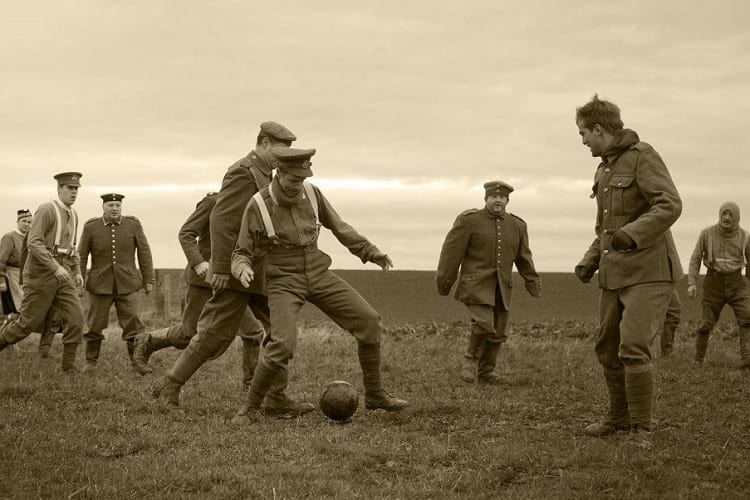
British and German soldiers playing a friendly soccer match in “no man’s land”(reenactment). (Wikimedia Commons)
War is deadly. It brings destruction and despair. It maims the population, slaughters the army and crumbles the government. The New York Times has reported that “Of the past 3,400 years, humans have been entirely at peace for 268 of them, or just 8 percent of recorded history.” According to estimates, throughout the course of human history, war has taken a toll on the life of about 1 billion people. In fact, in the last century itself, a minimum of 108 million people lost their lives due to war.
When we visualise about a war scene, thoughts about bullets, blood, and hatred are the first set of things to enter our mind. But for a minute, imagine two rival armies coming out of their trenches to play football and celebrate Christmas together in the middle of the battlefield. This is the inspiring true story of the Christmas Truce of World War I.
The Christmas truce of World War I
During the winter of 1914, the war was in its early stages. During the war, trenches became the lifeline of the soldiers, they protected the soldiers from artillery and enemy fire. By the November of 1914, a very long network of trenches had been laid. On both sides, the armies took defensive positions. The war had evolved in a tedious manner and it was commonly believed that the war would come to an end by the Christmas and the soldiers would return home.
However, things turned out to be different. It was Christmas Eve and the soldiers were still stuck in muddy trenches, there was no news of a trip to ‘home’. As dusk fell, it started snowing. The sight was magical. The British headquarters received a baffling message around 8:30 P.M., “Germans have illuminated their trenches, are singing songs and wishing us a Happy Xmas. Compliments are being exchanged but am nevertheless taking all military precautions.” As the trenches were often closely located, one side could easily hear the other. Throughout the starry night, both sides continued to entertain each other with Christmas carols. The German “Silent Night” met with the melodious British “The First Noel.” Not a single shot was fired that night.
At the break of dawn, they exchanged greetings however, both sides were still sceptical of the each other. Expecting a treachery, men on both the sides kept their hands glued to their guns. However, eventually, the feeling of betrayal gave way to trust and officers from both sides emerged and crossed the parapet of barbed wires that had been separating them and met in no man’s land. Not sure of what to do, they started to shake hands and exchange greetings.
Soon enough, the area of few yards between the trenches was filled with hundreds of ‘alive’ soldiers shaking hands with the men they were sent to kill. They exchanged small gifts such as uniform buttons, caps and food items. Men from both sides brought mugs and started to drink rum and smoke tobacco, celebrating Christmas. Not only this, they made arrangements to mutually bury their deads. Someone from the British side had received a football as a Christmas gift, soon a match kicked off. It was far from a professional football match, it was more of a bunch of war veterans kicking the ball around.
Mr. Felstead, the last known survivor of the Christmas truce retrospects to tell The Economist, “There could have been 50 on each side for all I know. I played because I really liked football. I don’t know how long it lasted, probably half an hour.” Nevertheless, the Germans have been reported to beat the British by a score of 3-2 in the match that took place that day. The men were exhausted by the humid conditions, still, they played their hearts out. Perhaps they knew that most of them wouldn’t live to recall this beautiful moment. The men seemed to have found a moment of peace and tranquillity amidst of the war that they might not get out alive of.

A colourized photo of British and German troops meeting in the no man’s land. (Cassowary Colorizations / Flickr)
But, soon the harsh realities of war made them return to their trenches and fight the men that they befriend a few moments ago. However, the message of the truce was out and widespread. The authorities from both the sides took stringent measures to make sure that there is no truce. War went on for 3 more years just to claim lives of about 38 million innocent people and soldiers.
Regardless of the fact that the Christmas truce was a mass mobilized event, it was not uniform. The truce was something that took place “scattered along a fairly small area of the front line” says Taff Gillingham. It was not just a single event, rather a series of events along the front line. A few casualties were reported on that day. Soldiers were shot by their enemies who didn’t anticipate a truce. The most reliable record of this recreation is available for the Royal Warwickshire Regiment which was posted in Flanders, near to the French border.
The spot is marked by a wooden cross and makes a popular tourist location. Another ‘Christmas Truce’ memorial was inaugurated on 12 of December 2014 by the Duke of Cambridge. It has been named as the “Football Remembers Memorial.”

A wooden cross now stands in the zone where the Christmas truce took place. (Redvers / Wikimedia Commons)
No one knows everything about the Christmas truce and everything known is mostly from personal records such as diaries, letter, and oral testimonials and cannot be easily accepted without scrutiny. This blurred story continues to remind the world the tryst with peace between Germans and British soldiers during the dark hours of World War I.
Enjoyed this article? Also, check out “Sir Adrian Carton de Wiart: The One-Eyed Invincible Soldier“.
Recommended Read:
Silent Night: The Story of the World War l Christmas Truce | By Mary Higgins Clark
Optional Visit:
Memorial Christmas Truce 1914 | Belgium
Fact Analysis:
STSTW Media strives to deliver accurate information through careful research. However, things can go wrong. If you find the above article inaccurate or biased, please let us know at [email protected].
RELATED
The post The Story of The Most Inspiring Football Match in History: Christmas Truce of World War I appeared first on .
]]>The post Hanns Scharff: The Extraordinary Interrogation Technique of a Nazi Interrogator appeared first on .
]]>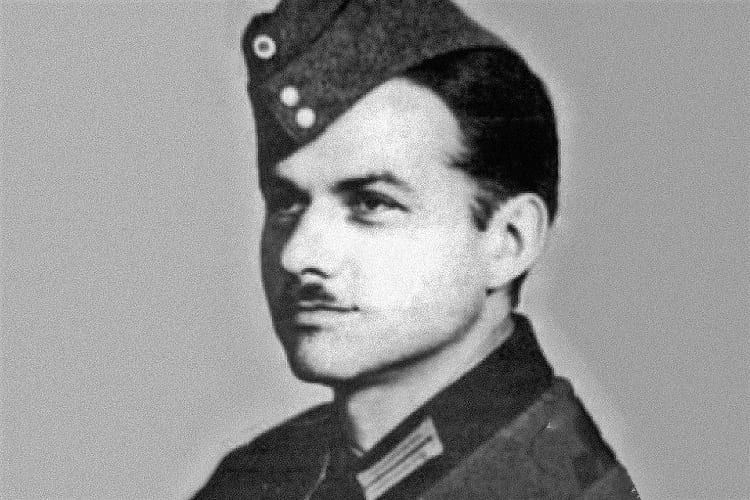
Hanns Scharff. (German Federal Archive)
When thinking of master interrogators, cruel individuals come to mind. Individuals who are able to inflict a great deal of physical or emotional pain on another without feeling empathy. A completely inhuman occupation but in the realms of society, it has always been an essential commodity, especially during times of war.
The same thought applies when thinking about the NAZIs, an idea of evil individuals. While this is untrue for the majority who were simply following a regime, others – many of those at the head of the party – took pride in their policies and practices. So when the two are combined – a NAZI interrogator – the phrase has a very dark connotation.
This particular interrogator worked his way up the ranks and by World War II oversaw prisoner camps known as Dulag Lufts. When enemies of the state were captured they were brought to the attention of the specialist known as Hanns Scharff. Fluent in English he quoted himself as “…the spider sitting on its web…”
From salesperson to interrogator
Scharff was born in 1907, in the East Prussian Empire. He grew up in the town of Leipzig where he studied art and learned the family’s textile business. On reaching adulthood he was sent to South Africa which made him fluent in English. He excelled in the sales division of a company, handling clients who considered him to be a gentleman to do business with.
Hanns married an English lady called Margaret Stokes who happened to be the daughter of a legendary RAF (Royal Air Force) Captain named Claud Stokes. This information would be a coincidence to some extent later in the story. The newly-wed Hanns and Margaret went on holiday to Germany one summer but it would turn into a longer stay than first hoped.
World War II broke out and still a German citizen, Scharff was sent to the Wehrmacht division for military training, destined for the Russian front. He was persistent to stay in Germany however and used his fluency in English to be promoted, becoming a Lance Corporal. The German ended up in Oberursel near Frankfurt, at an Intelligence and Evaluation Center operated by the notorious Luftwaffe Air Force. Their facility was where captured Allied pilots (excluding Soviets) were interrogated. Scharff became an Interrogation Officer.
The new officer was quick to enforce his own methods as he was far from impressed by current techniques. In the Dulag Luft, the captives would mostly come from downed British airplanes whose pilots would have been terrified about being captured by the Nazi regime. Rumours already circulated about the secret police called the Gestapo who were said to administer horrifying torture techniques.
Despite the guidelines of the Geneva Convention, illegal torture persisted. When some US Army pilots were captured, Scharff got his first opportunity. The work started before the meeting as he obtained every piece of information possible about them. He declined to wear a uniform; casual clothes were all he needed to extrapolate information.
I was like the spider sitting on its web, with all the elements I could use at hand, except the brutality.” -Hanns Scharff
Scharff’s interrogating technique
The prisoners would not find a spider but a gentleman. And this is why Hanns Scharff is so special. He was both a Nazi and an interrogator but chose not to do what was expected of him. The history of interrogation has always involved torture but he was brave enough to condemn it. No doubt at first the prisoners and his colleagues alike would have presumed it to be a trick but Scharff was highly successful in using psychology, and never force.
The fact he spoke perfect English meant he gained their trust. He created the illusion that he knew more than he knew, making the pilots feel that any details they gave were already common knowledge. Some even volunteered it due to being treated so well: They were taken on excursions to forests and the zoo with Scharff as their guide. They received medical care and a generous supply of food. Their good experience and treatment is reflected in the camp’s guestbook where the prisoners described the hospitality of the place.
The only devious aspect – a great weapon for the interrogator – was letting the prisoners know that he would give them to the infamous Gestapo if they did not cooperate or try to escape. But in honesty, he never did. Because for the one prisoner who said nothing – famous pilot ‘Gabby’ Gabreski – Hanns did not punish him. Even though Gabby never helped him they stayed friends and met again after the war was over.
Hanns knew that while these captives were his enemy by name, they were humans who did not start the war. He would be remembered and revered for never inflicting pain on another soul despite being expected to.
Influence on FBI and becoming a US citizen
Long after World War II finished, Scharff eventually settled in various countries – but never his – enemy, the US. The Pentagon was aware and persuaded him to work for them. Newspapers and magazines began to publish his methods. He reported for the US air force and would be an influence for many including former FBI agent Ali Soufan who was involved in investigating 9/11 and at Guantanamo Bay.
In retirement, Hanns would become a US citizen and followed his first love – art; designing mosaics at famous monuments such as Cinderella’s Castle at Disneyland. Hanns is an amazing example of standing up for what is right which is extremely heroic considering what took place in Nazi Germany.
He believed that people are people no matter where they are from and he treated the allies with the same respect he did the axis. Even when wars are taking place there are still shining lights like Hanns Scharff who are not just intelligent but brave enough to put it into practice.
Enjoyed this article? Also, check out “Sir Adrian Carton de Wiart: The One-Eyed Invincible Soldier“.
Recommended Read:
The Interrogator: The Story of Hanns Joachim Scharff, Master Interrogator of the Luftwaffe | By Raymond F. Toliver
Fact Analysis:
STSTW Media strives to deliver accurate information through careful research. However, things can go wrong. If you find the above article inaccurate or biased, please let us know at [email protected].
RELATED
The post Hanns Scharff: The Extraordinary Interrogation Technique of a Nazi Interrogator appeared first on .
]]>The post Sir Adrian Carton de Wiart: The One-Eyed Invincible Soldier appeared first on .
]]>
An impressive painting of Sir Adrian Carton de Wiart by Sir William Orpen, 1919. (National Portrait Gallery / Wikimedia Commons)
If you were born into a Belgian aristocratic family how would you spend your life? Would you spend it fighting in three different wars over the span of 50 years, or live a life of luxury? For most of us, the answer to that question would be a life of luxury, unless you are Adrian Carton de Wiart. Sir Adrian Paul Ghislain Carton de Wiart VC, KBE, CB, CMG, DSO was one of the most decorated British Army officers, telling of whose war exploits would require the greats like Tarantino, Scorsese, and Nolan to come together to do any justice to his biopic.
The man had sustained serious injuries a total of 11 times over his military career, losing an arm and an eye in the process. And that doesn’t even start to scratch the surface of his adventurous life.
Joining the army
Born in 1880 in Brussels, to a Belgian father and an Irish mother, Sir Adrian spent most of his youth at a Catholic boarding school in England. He then enrolled at Balliol College, Oxford. For most people war is a way of resolving disputes or just a display of power, but for some it is recreation. Sir Adrian was one of those people. At the age of 19, Sir Adrian joined the army by lying about his age and his name. He claimed to be a 25-year-old drifter named ‘Trooper Carton‘.
Starting his professional life as a soldier in the Second Boer War, he injured his stomach and groin very early on, while fighting in South Africa. Because of his injuries, he was invalided home where he was met by his infuriated father, who was still unaware of his son leaving college to join the army. Sticking to doing what he loved, Sir Adrian went back to South Africa once his wounds had healed.
He was very concerned about his physical fitness, and therefore he regularly ran, jogged and played sports. Among his peers, he was known to be charming, delightful but a foul-mouthed man.
A very well-connected man in Europe, Sir Adrian spent his time away from work travelling extensively. He made friends with quite a few people in high places. Till the beginning of the First World War, like most army officers of imperial England, he was stationed at a number of places including India.
Role during World War
During WWI, he was assigned to the Camel Corps in British Somaliland to establish his control over the followers of Mohammed bin Abdullah. He lost his left eye after being shot in the face when they attacked an enemy fort. But losing an eye did not dampen his spirits because he probably liked how he looked with an eyepatch. He was then given the chance to lead his own infantry battalion into battle in the bloody trenches of the Western Front. Here he lost his left arm after taking some shrapnel. When doctors refused to amputate some infected fingers, he did the deed himself.
Then he was shot in the skull for the second time in the Battle of Somme along with his ankle. But his gallantry there was awarded in the form of the Victoria’s Cross – the highest military honour in England. He was wounded 8 times during the First World War, and six times he injured himself serious enough to be granted mentions in dispatches. While for most of us this feels like a horror of the third kind, he later wrote in his autobiography Happy Odyssey: “Frankly, I enjoyed the war; it had given me many bad moments, lots of good ones, plenty of excitement and with everything found for us”.

Photo of Sir Adrian, when he was lieutenant colonel during the Great War. (Henry Walter Barnett / IWM)
After the First World War, he was sent to Poland as a representative of the British Government. Poland gave him an estate near the borders where he spent most of his time hunting. After the Nazi invasion of Poland, he had to return to England. Even at the age of 60, he led an operation to halt the advancing Nazi invasion of the Norwegian city of Trondheim.
Possibly the most interesting part of his story is when his plane crashed off the coast of Italian-colonized Libya. He swam to the coast where he was captured by the Italian army and sent to a prisoner camp in Italy. He tried to escape the camp five times, once evading and being captured for eight days disguising as a local despite his eyepatch and lack of any knowledge of the Italian language. He was released in 1943 and sent to England with the message of Italian surrender.
Winston Churchill, the prime minister of Britain, had fought beside him and also wrote the foreword to his Autobiography. Churchill sent him to China as a special representative where he befriended Chiang Kai-Shek and helped him fight the Japanese. It is also said that at a dinner party in China he had been very rude to Mao Tse-Tung. He retired from the Army in 1947, after fighting in 3 wars and injuring himself 11 times. He lived on till he was 83 years old, passing away in 1963.

Sir Adrian (at the back row) and other participants of Cairo conference in 1943. (U.S. Government)

1943: Sir Adrian Carton smoking a tobacco pipe in Cairo, Egypt. (Oulds D C (Lt), Royal Navy Official Photographer / Imperial War Museums)
We have talked a lot about his adventurous life as a soldier, but his personal life was not ordinary either. He was married to an Austrian Countess, Countess Friederike Maria Karoline Henriette Rosa Sabina Franziska Fugger von Babenhausen for 41 years, and she didn’t even get a mention in his autobiography. We cannot blame him considering how interesting his life had been, one could easily forget about his Countess wife of 41 years.
Having an unkillable soldier like Sir Adrian on your team would really help an army win a war. We cannot give him the whole credit of winning the World Wars, but a man like him deserves more than just a few medals.
Enjoyed this article? Also, check out “Simo Hayha: World’s Deadliest Sniper with 505 Confirmed Kills“.
Recommended Book:
Happy Odyssey | By Adrian Carton de Wiart
Fact Analysis:
STSTW Media strives to deliver accurate information through careful research. However, things can go wrong. If you find the above article inaccurate or biased, please let us know at [email protected].
RELATED
The post Sir Adrian Carton de Wiart: The One-Eyed Invincible Soldier appeared first on .
]]>The post Simo Hayha: World’s Deadliest Sniper with 505 Confirmed Kills appeared first on .
]]>
Simo Hayha posing with his honorary rifle. (Finnish Military Archives / Wikimedia Commons)
Simo Hayha, famously dubbed as “The White Death,” is regarded as one of the greatest marksmen in military history. The Finnish man from Karelia earned more than 500 kills while bravely defending Finland against the mighty Soviet invasion during World War II. His role in the war earned him many medals, and much respect, making him an immortalized national hero.
Simo was born on 17th December 1905, to a Lutheran family who lived in the Karelia region, which is now located in modern-day Russia. Simo was the second youngest among his eight siblings. At the age of 20, he enrolled in the Finnish voluntary militia, where he served for about a year. It was here that he acquired the training that would go on to make him one of the most revered snipers in history. Before the onset of the Winter War, Simo spent most of his day farming and hunting.
The Winter War
In 1938, Europe was in complete disarray. Hitler’s rise to power was greatly threatening the peace and stability of the region. And like most countries, the Soviet Union were extremely wary of this development. Worried about an invasion from the north, in April the same year, the Soviet Union sent representatives to speak with the Finnish government. Here, they expressed great concern over Nazi Germany and a probable invasion of Russia through parts of Finland. The Finnish government, at the time, were officially neutral. While they were not ready to launch an offensive, they assured the representatives that any Nazi incursion on its borders would be met with swift resistance. This didn’t go down well with the Soviets though.
About thirteen years prior, Hitler’s infamous manifesto, Mein Kampf, was published. In it, he clearly mentions the need for Germany to invade Russia. This and the political climate at the time convinced the Soviet Union that an attack was imminent. Rather than wait around for things to reach such a critical stage, the Soviets were determined to make the first move, and blatantly refused any promises from smaller countries. As negotiations began to break down, on November 30, 1939, the Soviet Red Army invaded Finland, marking the beginning of the 105-day long Winter War.
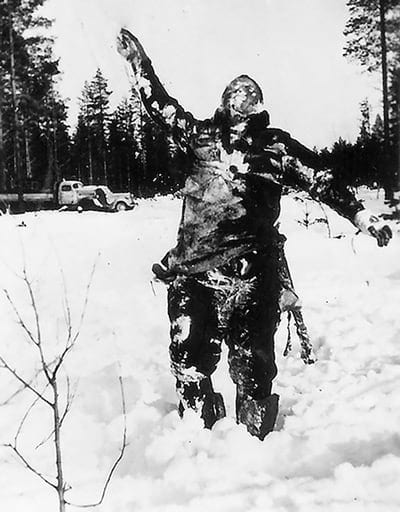
Dead Russian Soldier erected by Finish army as an intimidation to the Russian during the Winter War. (Фотокор / Wikimedia Commons)
Strategies used by Simo Hayha during the war
On hearing this development, Simo Hayha sprang into action. He packed himself some food, put on some plain white camouflage, picked up his rifle, and darted towards the front, which was not too far off from his home. He would make his way through the bush until he found himself a perfect vantage point. Once here, he would take the position and wait for a target. This wait could last anywhere from a few hours to a few days. One must remember that temperatures on the battlefield never rose above zero degrees. Despite the extreme cold, Simo would hideout in the wilderness, completely committed to the cause.
Soon, Simo realized that the Russians were using already established routes to move troops and supplies to the front. This made it easier for the sniper to find suitable spots to lay low. Simo would employ a variety of techniques to ensure that he was never detected. Apart from hiding himself meticulously, Simo, as mentioned previously, would wear a white camouflage that helped him blend into his surroundings. Additionally, he never used a scope on his rifle, fearing that the sun might reflect on the glass and give away his position. All his targets were eliminated from a great distance with unassisted vision. Further, Simo always kept some snow in his mouth to prevent his breath from steaming. Such methods ensured that the Soviets could never figure out his exact location.
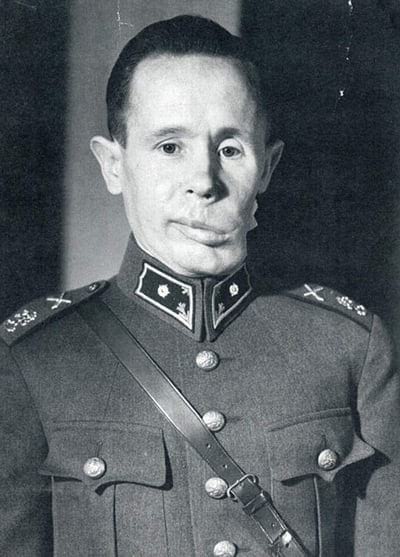
Simo Hayha after facial reconstruction due to an exploding bullet that blew off half his jaw. (Finnish Military Archives / Wikipedia Commons)
As the war progressed, Simo continued to make a dent in the Soviet advance. On average, he was gaining 5.5 kills a day. His highest tally in a day was a remarkable 40 confirmed kills. However, just about a week before the end of the war, on March 1940, Simo was injured severely by an exploding bullet that shattered his jaw. After being admitted to the hospital, Simo was required to undergo facial reconstructive surgery and remained in a coma until the day the war ended on March 13, 1940.
After the end of the war, Simo humbly returned to his prior routine of hunting and farming. In 1970, the war hero moved to Rasila, Ruokolahti, where he lived in a one-bedroom apartment until 2001.

Grave of Simo Hayha now lies in Ruokolahti Church Graveyard, Finland. (Klokster / Wikimedia Commons)
In 2002, Simo breathed his last at a war veteran’s hospital in Hamina at the ripe old age of 96.
Enjoyed this article? Also, check out “Hanns Scharff: The Extraordinary Interrogation Technique of a Nazi Interrogator“.
Recommended Read:
A Frozen Hell: The Russo-Finnish Winter War of 1939-1940 | By William Trotter
Soviet Union vs Finland – The Winter War 1939 | YouTube
Fact Analysis:
STSTW Media strives to deliver accurate information through careful research. However, things can go wrong. If you find the above article inaccurate or biased, please let us know at [email protected].
RELATED
The post Simo Hayha: World’s Deadliest Sniper with 505 Confirmed Kills appeared first on .
]]>